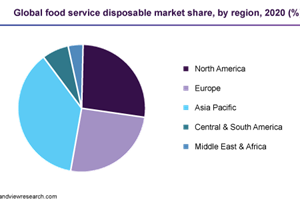The global market for biodegradable disposable tableware is poised for substantial growth, expecting a 7.6% CAGR from 2023 to 2030. These eco-friendly products, made from renewable resources like sugarcane, bamboo, and paper, aim to reduce methane emissions and combat plastic waste. Stringent regulations limiting plastic-based cutlery have boosted the demand for biodegradable and wood-based alternatives. This shift is evident in fast-food outlets, small snack businesses, and food delivery chains, all increasingly adopting sustainable cutlery. Market players are actively innovating to offer even more environmentally friendly solutions. For instance, in July 2022, Social Venture Marine Innovation partnered with French brand ARGO to export seaweed by-product-based eco-friendly plates and cups, known as "Janoodam," promoting nature preservation. These initiatives drive the adoption of biodegradable disposable tableware, fostering a greener and more sustainable future.
Some of the major market players are Biotrem, Better Earth, and Pactiv. They are contributing massively through mergers, collaborations, and more.
Top of Form
Segmental Outlook
he global biodegradable disposable tableware market is categorized by material, product type, and end-user. Materials include synthetic biodegradable plastics like PCL and PBS, as well as bio-based biodegradable plastics such as PLA, PHB, and starch-based options, alongside paper and paperboard derived from wood or non-wood sources like straw, leaves, bamboo, and sugarcane. Product types encompass cutlery, bowls, plates, cups, trays, and others, catering to end-users in food service, households, and institutions (schools, hospitals, cinemas, and railways). The paper and paperboard sub-segment is anticipated to hold a significant market share, driven by increasing social and environmental awareness favoring easily disposable materials.
Top of Form
The Food Service Sub-Segment is Anticipated to Hold a Considerable Share of the Global Biodegradable Disposable Tableware Market
The food service sub-segment is expected to dominate the global biodegradable disposable tableware market due to factors like increased fast-food demand, online food delivery popularity, and government regulations against plastic waste. Key industry players are investing in biodegradable solutions to meet demand and align with sustainability goals. For instance, the "cutout cutlery" campaign by "Habits of Waste" successfully influenced food delivery organizations to reduce single-use plastic cutlery waste in August 2021. The adoption of biodegradable tableware in the food service sector signals a positive shift toward reducing plastic waste and promoting eco-friendly dining experiences, a trend expected to persist as sustainability gains importance among consumers and businesses.
Regional Outlook
The global biodegradable disposable tableware market is further segmented by geography, including North America (the US and Canada), Europe (UK, Italy, Spain, Germany, France, and the Rest of Europe), Asia-Pacific (India, China, Japan, South Korea, and the Rest of Asia), and the Rest of the World (the Middle East & Africa and Latin America). Among these regions, Asia-Pacific is anticipated to hold a prominent share of the global market, primarily due to the widespread implementation of regulations banning single-use plastics in countries like India and China.
The Asia-Pacific Region is Expected to Grow at a Significant CAGR in the Global Biodegradable Disposable Tableware Market
The Asia-Pacific region is set for significant growth, fueled by a shift towards adopting biodegradable disposable tableware due to bans on single-use plastics. Australia, for instance, implemented a ban in November 2022, covering various items like straws, cutlery, bowls, and polystyrene foam food containers, with businesses facing substantial fines for violations. Across Asia, countries are at the forefront of embracing biodegradable solutions to address environmental concerns linked to single-use plastics. With a combination of rapid economic growth and heightened environmental awareness, governments, businesses, and individuals are collectively working to diminish the environmental impact of plastics. In June 2023, China, leveraging its sizable population and industrial capacity, led the charge in advocating for biodegradable disposable tableware, driven by stringent government regulations on single-use plastics that spurred a surge in production and usage of biodegradable alternatives.
researchandmarkets.com













